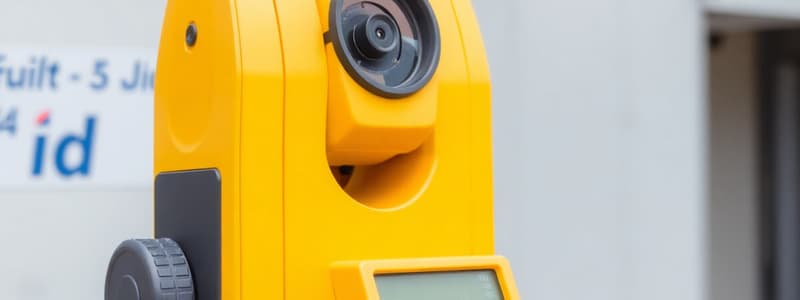Podcast
Questions and Answers
What are the main component parts of a Digital Theodolite?
What are the main component parts of a Digital Theodolite?
A Digital Theodolite typically includes a telescope, electronic distance measurement (EDM) device, LCD display, and battery.
List common sources of errors in a Total Station.
List common sources of errors in a Total Station.
Common sources of errors in a Total Station include instrumental errors, systematic errors, and environmental factors.
Briefly explain the temporary adjustments required for a Total Station.
Briefly explain the temporary adjustments required for a Total Station.
Temporary adjustments of a Total Station include leveling the instrument, centering over the survey point, and orientation to a reference line.
Differentiate between Active and Passive systems in Remote Sensing.
Differentiate between Active and Passive systems in Remote Sensing.
What is Remote Sensing?
What is Remote Sensing?
Name four applications of Remote Sensing.
Name four applications of Remote Sensing.
What is the basic principle of Photogrammetry?
What is the basic principle of Photogrammetry?
Flashcards are hidden until you start studying
Study Notes
Digital Theodolite
- A digital theodolite is a surveying instrument used to measure angles.
- It is a precision instrument that utilizes electronic sensors for measuring horizontal and vertical angles.
- It consists of:
- Telescope
- Horizontal and vertical circles
- Electronic sensors for angle measurement
- Digital display
- Data storage
Common Sources of Errors in a Total Station
- Instrumental errors: Due to imperfections in the instrument itself (e.g., misalignment, calibration errors).
- Environmental errors: Caused by atmospheric conditions (e.g., temperature variations, refraction).
- Operator errors: Human factors like improper handling, target misalignment, and reading errors.
- Target errors: Errors due to the target's characteristics (e.g., size, shape, visibility).
Temporary Adjustments of a Total Station
- Leveling: Ensuring the instrument is perfectly level before taking measurements.
- Collimation: Adjusting the telescope to ensure the line of sight aligns with the instrument's axis.
- Focus: Optimizing the telescope focus for accurate measurement.
Active and Passive Systems in Remote Sensing
- Active remote sensing: Systems emit their own energy source, which is then reflected back to the sensor.
- Passive remote sensing: Systems rely on natural energy sources like the sun.
Remote Sensing
- Remote sensing is the acquisition of information about an object or phenomenon without direct contact.
- It captures data from a distance using sensors mounted on platforms like satellites, aircraft, or drones.
Applications of Remote Sensing
- Land use and cover mapping: Identifying and quantifying land cover types.
- Environmental monitoring: Tracking changes in vegetation, water bodies, and pollution levels.
- Disaster management: Supporting disaster response and mitigation by providing timely information.
- Agriculture and forestry: Yield estimations, crop health monitoring, and deforestation detection.
Photogrammetry
- Photogrammetry involves obtaining measurements and three-dimensional information from photographs or images.
- The principle involves measuring distances, elevations, and orientations through geometric analysis of overlapping photographs.
- It's used in mapping, topographic surveys, and creating 3D models.
Studying That Suits You
Use AI to generate personalized quizzes and flashcards to suit your learning preferences.




